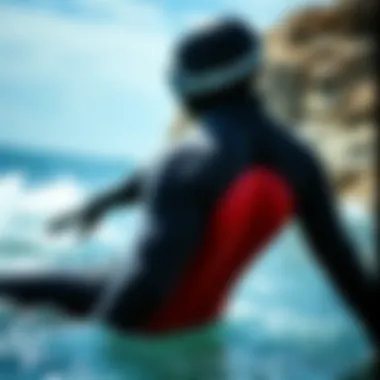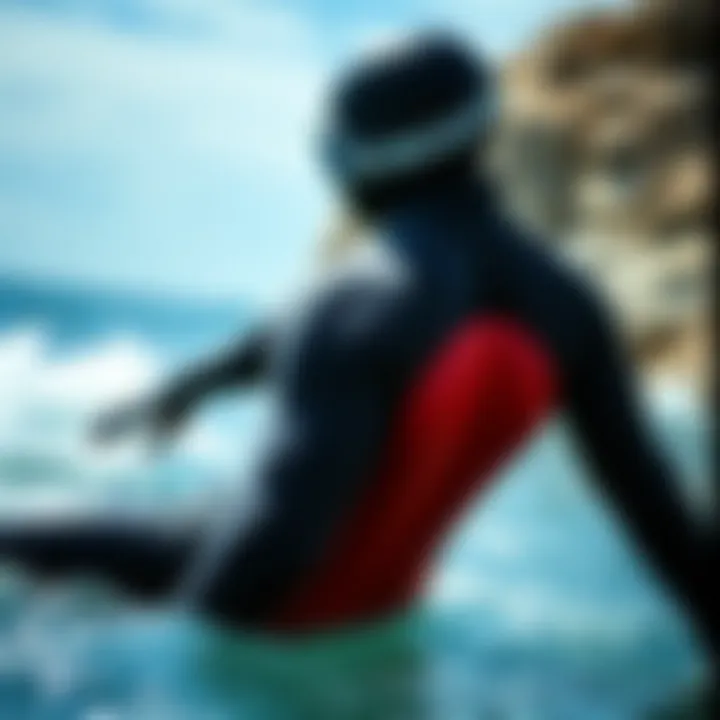Choosing the Right Wetsuit for Larger Bodies


Intro
Selecting a wetsuit can feel like finding a needle in a haystack, especially when you have a larger body type. Wetsuits are not just about keeping warm in chilly waters; they form the essential layer of safety and comfort as you navigate through waves and choppy seas. When it comes to kiteboarding, your performance can hinge on the right fit and material of the wetsuit.
But let’s face it, the market can be a puzzling maze with varying materials, styles, and fits available. A knowledgeable choice isn’t merely about price; it’s about what’ll allow you to move freely while staying warm. This article dives deep into the essentials of choosing the right wetsuit, particularly aimed at those embracing larger body types. In doing so, we will highlight key aspects like fit, fabric, and brands that cater specifically to larger athletes.
With numerous choices, you want a wetsuit that's more than just a second layer – it should be a reliable partner when you’re out there kiteboarding. While it’s tempting to just grab the first suit that looks decent, it pays to understand how to identify what features matter most for your build and riding style. So, let’s gear up and dive into the insights!
Understanding Wetsuits
When it comes to enjoying water sports, understanding wetsuits is like knowing the ropes of sailing. For larger body types, this knowledge isn't just useful; it's essential. Wetsuits serve various purposes, from improving a swimmer's performance to keeping someone warm during those chilly kiteboarding sessions. Selecting the right wetsuit is a foundational step that can influence both comfort and efficiency in water activities.
The Purpose of a Wetsuit
Wetsuits primarily exist to keep the wearer warm by trapping a thin layer of water between the suit and the skin. This water gets warmed by the body heat, providing an insulating layer that helps control body temperature, especially when the water's colder than a frozen custard stand. For those heftier folks looking to enjoy kiteboarding, this function becomes doubly important; staying warm equates to staying active and comfortable.
Key Components of Wet Suits
Wetsuits might look simple on the surface, but they're a product of careful engineering. Here are three key components that define surf or kite boarding wetsuits, particularly for larger body types:
Fluid dynamics
Fluid dynamics is about understanding how water flows around the body, and for larger athletes, this can raise some unique considerations. A well-designed wetsuit enhances hydrodynamics, allowing the rider to glide through the water rather than plow through it like a bulldozer. The beauty of a good wetsuit lies in its ability to reduce drag while maximizing buoyancy. For larger body types, this allows for smoother motion, leading to less fatigue and more enjoyment on the water. Sometimes, a poorly designed wetsuit can increase resistance, turning what should be a fluid ride into a battle against the elements.
Insulation properties
Insulation properties play a vital role in the effectiveness of a wetsuit. Neoprene variations provide differing levels of thermal protection. For instance, a thicker suit may offer better insulation, yet it also might limit movement somewhat, which can be a concern for kiteboarders requiring agility. The choice often comes down to balancing warmth and flexibility. Larger individuals often face a further challenge, as finding an insulating wetsuit that fits well without compromising comfort can feel like searching for a needle in a haystack.
Mobility features
Mobility is crucial, especially for those who enjoy dynamic water sports like kiteboarding. Mobility features in wetsuits vary, including specialized cuts and flexible joints that allow bigger athletes to move more freely. A solid suit should allow for reaching up, bending down, and twisting without restrictions, similar to how a dancer glides across a stage. However, suits that offer these features often come at a premium. The challenge remains: ensuring the right fit while not sacrificing essential movement capabilities.
Choosing the right wetsuit requires a solid understanding of how these components work together to enhance performance in the water, particularly for those adapting the gear to larger body types. A wetsuit should be a second skin, one that supports rather than constrains.
Challenges for Larger Body Types
Selecting a wetsuit that accommodates larger body types presents unique challenges. It’s not merely a question of aesthetics; fit and function intertwine here, influencing overall performance in the water. Having the right wetsuit ensures comfort, insulation, and mobility, which are all critical for activities like kiteboarding. As the saying goes, "you can’t hit the ground running if your shoes don’t fit," and the same applies to wetsuits. When you're out on the waves, a poorly fitting wetsuit can lead to discomfort, distractions, and even hinder your performance.
Fit and Comfort Issues
One of the biggest hurdles in finding a wetsuit for larger body types is achieving the ideal fit. Often, those who fall outside typical sizing find themselves squeezed into options that don’t cater to their frame, leading to a host of discomforts. A wetsuit that feels restrictive reduces the joy of kiteboarding. It’s important to note that a snug fit is essential for insulation but should never border on constricting. The right wetsuit almost feels like a second skin, allowing freedom of movement while still providing warmth.
Key considerations for fit and comfort include:
- Compression: A wetsuit that’s too tight can inhibit circulation and restrict movement, which may lead to fatigue faster than you can say, "surf’s up!"
- Size Variations: Brands have different sizing charts, making it crucial to try on various wetsuits to find what works best. Some companies cater specifically to plus sizes, ensuring a better fit.
- Design Elements: Features like flatlock seams and soft linings help in enhancing comfort by reducing chafing and irritation.
Incorporating personal measurements into the shopping process is wise. Many brands provide tailored fits or customizable options that ensure a better fit, taking you closer to that perfect match.
Movement and Flexibility Concerns
Another challenge for larger body types is maintaining flexibility while outfitted for cold water. When selecting a wetsuit, you must ensure that while it fits snugly, it also allows you to move your limbs freely. A wetsuit that fails to provide adequate stretch can lead to frustration, especially when kiteboarding requires sudden shifts in movement to balance and navigate the wind and water.


To improve movement and flexibility, consider the following:
- Material Selection: Look for materials that boast a high stretch capability, like limestone neoprene or even some premium synthetic blends. This ensures you can reach for that kite-hand without feeling like you're in a straitjacket.
- Design Features: Wetsuits with articulated elbows and knees are designed with movement in mind. They’ll give you that extra allowance you need when maneuvering on the board.
- Thickness Variations: Thicker wetsuits may provide better insulation but can also restrict movement. Striking the right balance is key; assessing the water temperature and session duration is essential.
Ultimately, you want a wetsuit that feels like a warm hug, not a vice grip.
Larger body types face distinct challenges when it comes to wetsuits. Understanding these issues at the outset can aid in making an informed decision, leading to a rewarding experience on the water. Using user-centered design elements, brands are increasingly focusing on producing wetsuits that cater to the needs of larger athletes, ensuring they can enjoy the thrill of kiteboarding without discomfort or frustration.
Selecting the Right Wetsuit
Choosing the right wetsuit is a foundational step for anyone serious about water sports, especially for larger body types. The right wetsuit not only enhances comfort and mobility but also ensures thermal protection and overall performance while out on the water. When you’re kiteboarding, you need all the right gear to enable your performance.
This section will dig into the nitty-gritty of wetsuit materials, sizing guidelines, and design features, helping you make an informed decision. The right wetsuit is like finding the perfect pair of shoes; when it fits well, it makes all the difference. Without the right selection, you may face discomfort, restricted movement, or even hypothermia in cold water.
So, let’s break it down and look closely at what a big-boned adventure seeker should consider when selecting a wetsuit.
Material Considerations
Neoprene types
Neoprene is the bread and butter of wetsuit construction. It’s a sturdy synthetic rubber that serves as the primary material, offering insulation and buoyancy. Not all neoprene is created equal, though. There are several types available.
The key characteristic here is flexibility. For larger athletes, a high-stretch neoprene, such as limestone-based neoprene, is particularly beneficial. It provides excellent range of motion, which is essential for those who don’t want to feel restricted.
The unique feature of limestone neoprene is its environmentally friendly nature, introducing less toxic emissions during production. However, it might be less durable than some petroleum-based options. That’s what you want to weigh—balancing eco-friendliness with longevity.
Thickness variations
Wetsuits come in various thicknesses, typically ranging from 2mm to 6mm. The thickness you choose influences insulation properties and flexibility.
A thicker suit, for example, is terrific for colder waters, providing ample warmth. But the trade-off might be a lack of mobility, which could hinder your kiteboarding performance. For a larger body type, finding a balance here is crucial. A 4mm wetsuit might provide warmth without compromising too much on movement, making it a popular choice for transitional weather.
Another unique feature to consider is the layering. Many brands now offer options where you can peel down thickness in certain areas, giving you customized insulation where you need it most while allowing easier maneuverability elsewhere.
Breathability factors
When it comes to wetsuits, breathability is often overlooked, yet it shouldn't be. Breathable fabrics enable moisture to escape, preventing that clammy feeling that is more pronounced in larger sizes.
The key characteristic here is how that breathability keeps you comfortable during prolonged wear. Some suits incorporate mesh panels or specialized fabrics that allow better airflow. This can be a game changer for a larger athlete who is prone to overheating.
However, consider that while breathability is fantastic, added panels may expose you to more water. Thus, you need to make sure you find the right balance that caters to your comfort without sacrificing warmth when it really counts.
Sizing Guidelines
Measuring body dimensions
To avoid feeling like you have a straitjacket on, taking the time to measure your body correctly is essential. Understanding the width of your chest, hip size, and inseam can direct you toward the right fit.
The key characteristic of measuring body dimensions is accuracy. A snug fit reduces water entry while allowing for freedom of movement. Using a cloth tape measure, you can DIY at home or visit a pro shop for help.
Moreover, each brand has its nuances in sizing, so these measurements help you make an informed decision and ensure a better comfort level while riding the waves.


Understanding size charts
Size charts can feel like a mystery, especially when purchasing online. Familiarizing yourself with them can save a lot of heartache down the line.
The key characteristic of size charts is that they help correlate your body measurements with manufacturers' sizes. Knowing whether they run small or large can prevent a regrettable purchase. Each manufacturer might have its quirks—some list sizes based on height and weight, while others have specific dimensions for different body types.
Depending on the chart’s design, it can help you make an educated choice, ensuring your selection fits comfortably—like a glove.
Design Features
Seam types
Seam construction plays a pivotal role in ensuring warmth and durability in wetsuits. There are multiple types of seams, each offering various benefits. Glued and blind-stitched seams, for example, prevent water entry, ensuring you stay warm.
The key characteristic of good seams is their effectiveness at keeping water out while providing flexibility. For larger body types, this is essential. Quality seams enhance the wetsuit’s longevity and performance.
However, extra seam taping could mean additional bulk, affecting flexibility. Thus, an effective seam design can balance warmth and movement without making the suit feel like a lead coat.
Zipper placements
Zipper placement is another detail not to overlook. Wet suits can come with back zippers, chest zippers, or even no zippers. Positioning significantly impacts how easy getting into and out of the suit is, not to mention comfort during use.
The unique feature of chest zippers is they often allow for better waterproofing due to their high placement. For a larger athlete, this can be better for comfort when paddling out.
However, some may find back zippers easier to manage alone. Each type has its own benefits and challenges, with some zippers being more prone to wear and tear, which needs ample attention.
Additional padding
Additional padding in crucial areas, like the knees and elbows, can provide extra support and better durability, especially for larger body types. A wetsuit with knee pads, for instance, can be a life-saver when hitting the water hard.
The key characteristic of padding is that it absorbs impact and can enhance longevity in your wetsuit. For someone spending hours kiteboarding, added protection like this makes all the difference.
However, too much padding can impact flexibility, so it's vital to find a well-designed wetsuit that blends these extra features without limiting your range of motion.
Choosing a wetsuit should be about ensuring comfort, protection, and performance. This balance is the pathway to enjoying your aquatic adventures and flying across the waves. Settling for anything less could leave you feeling like you’re out of sorts in more ways than one.
Recommended Brands for Larger Athletes
Choosing the right wetsuit isn’t just about grabbing a name brand off the shelf. It’s often a labor of love, especially for individuals with larger body types. The right wetsuit can make the difference between an exhilarating day on the water and an uncomfortable battle against a constantly shifting suit. In this section, we'll discuss brands that cater specifically to larger athletes, ensuring your time spent kiteboarding or engaging in any water sport remains enjoyable and free from unnecessary distractions.
High-Performance Options
Brand A overview
When it comes to wetsuits that prioritize performance without compromising on fit, Xcel Wetsuits stands out. It has gained recognition for offering a wide range of sizes while maintaining a commitment to quality. Specifically, Xcel caters to bigger builds, with tailoring that accommodates broader shoulders and waist sizes. One key characteristic that sets Xcel apart is their use of what they call "Celliant" fibers, which claim to recharge muscles and boost performance during water activities. This feature is not just for show; it provides a tangible benefit for larger athletes who need all the energy they can muster. The only disadvantage? The higher price point might give some budget-conscious kiteboarders pause, but the benefits could justify the cost.
Brand B performance insights
O'Neill is another powerhouse in the wetsuit industry, renowned for both fit and functionality. The brand has caught the eye of many larger athletes thanks in part to its innovative "Technobutter" neoprene, which offers superior flexibility and warmth without bulk. What makes this brand particularly appealing is their design philosophy that incorporates seams placed in non-restricted areas, allowing for a more natural range of motion. This is crucial when you're out on the water, balancing on a kiteboard and making those stylish turns. That said, some user feedback indicates that the sizing can be inconsistent, so potential buyers may need to try on a couple of styles before settling on the perfect fit.
Affordable Alternatives


Brand value offerings
Rip Curl has built its reputation on offering quality wetsuits at price points that won't break the bank. Their "Dawn Patrol" line is particularly popular among folks looking to balance budget with performance. They focus on offering a fit that feels good for larger frames, combining comfort with an effective thermal layer. The neoprene used is stretchy but durable, giving you both the freedom to move and the reassurance that your gear won't fall apart after a few seasons. However, some users have mentioned that while the suits do provide good insulation, they may not be suitable for extremely cold conditions.
Brand user feedback
Then there's Billabong, a brand that has earned a loyal following for their thoughtful designs aimed at bigger body types. From the moment you slip into one of their suits, you can feel the difference— Billabong integrates feedback directly from users into the design process. One distinctive feature is their "Xero" technology, which enhances warmth and minimizes water entry through expertly placed seals. Reviews from larger athletes often mention how much they appreciate these small but significant details. However, it’s worth noting that while they’re functional, some users have pointed out that the aesthetic choices may lean on the more traditional side, not always catering to those wanting bold colors or designs.
"The right wetsuit is not just gear; it's a lifeline to the sport we love."
In summary, identifying suitable brands for larger athletes involves a mix of performance, comfort, and price considerations. When you choose wisely, the right wetsuit will feel like a second skin, giving you the confidence to take on the waves without the distraction of discomfort. Options like Xcel, O'Neill, Rip Curl, and Billabong tap into specific needs for larger body types, ensuring those on the water can focus on what truly matters—enjoying every exhilarating moment.
Wetsuit Maintenance Tips
Maintaining your wetsuit is not just about looks; it's crucial for performance and longevity. A well-kept wetsuit can make the difference between a comfortable ride on the waves and an irritating experience. Those who participate in kiteboarding or water sports face various environmental factors, such as salt, sand, and UV rays, all of which can take a toll on the material. The following sections provide insights on best practices for cleaning and storing your wetsuit, ensuring that it not only lasts longer but also performs at its peak whenever you’re ready to hit the water.
Cleaning Best Practices
The first step in proper wetsuit maintenance is cleaning it thoroughly after each use. Here’s a checklist to help guide the process:
- Rinse Immediately: As soon as you’re out of the water, rinse your wetsuit in fresh, cool water. This removes salt, sand, and chlorine, preventing these substances from degrading the fabric over time.
- Use a Mild Soap: If your wetsuit has been heavily soiled, it can benefit from a gentle wash with a wetsuit-specific soap. Regular detergents can be harsh, so it’s best to avoid those.
- Avoid the Washing Machine: While it might seem easier, tossing your wetsuit into the washing machine can lead to damage. Wetsuits are delicate, and the machine can stretch out the material.
- Air Dry Properly: After washing, hang your wetsuit upside down to air dry. This method allows moisture to escape without putting stress on the seams. Avoid direct sunlight and heat sources, as they can cause fading.
Following these cleaning practices ensures the quality of your wetsuit, translating into better comfort and performance when you’re out on the water.
Storage Guidelines
Proper storage of your wetsuit can also significantly extend its lifespan. Here are some important tips to consider:
- Store in a Cool, Dry Place: The ideal environment for your wetsuit is a cool, dry area, away from direct sunlight. Long exposure to UV rays can break down the materials.
- Use a Hanger Designed for Wetsuits: A padded hanger is preferable to prevent stretching and distortion of the shoulders. Alternatively, you can lay it flat to avoid any creases.
- Avoid Folding: If possible, avoid folding your wetsuit as this may create creases that become hard to remove and can compromise the fabric's integrity over time.
- Check Seasonally: If you're not planning to use your wetsuit for a while, consider doing a seasonal check. Look for signs of wear and repair any small issues before they develop into bigger problems.
Storing your wetsuit correctly helps maintain its fit and flexibility, which are vital for the high-energy activities like kiteboarding.
"A bit of care goes a long way; invest time in maintenance to ensure your wetsuit serves you well for many adventures to come."
In summary, proper maintenance of a wetsuit is key for anyone who enjoys water sports. By adhering to these cleaning and storage practices, you can prolong the life of your gear while ensuring that it performs optimally each time you venture out into the waves.
The Future of Wetsuit Design
Wetsuit design is entering a new phase, especially in catering to diverse body types. The future focuses not just on functionality, but also crafting an experience that accommodates various shapes and sizes, including those of larger athletes. As the water sports community grows, the demand for better solutions has never been greater. Wetsuits must combine advancements in materials with an understanding of body dynamics to enhance both performance and comfort.
With advancements on the horizon, it's vital to grasp how innovative materials and cutting-edge technologies can transform wetsuit functionality while addressing comfort and fit issues that larger body types often experience. For anyone serious about kiteboarding or other water sports, potential breakthroughs in wetsuit design will not only enhance individual performance but also make these activities more inclusive.
Innovative Materials and Technologies
Emerging materials are reshaping the wetsuit landscape. Traditional neoprene is being joined by a host of new synthetic fabrics designed to maximize performance and comfort. Some of these materials offer significant benefits:
- Lightweight Insulation: New thermal materials trap warmth without adding unnecessary weight. This enhances buoyancy, allowing for easier movement in the water.
- Eco-Friendly Options: Brands are beginning to introduce eco-conscious materials made from recycled resources. This not only meets demand for sustainability but also provides excellent performance characteristics.
- Fluid Dynamics Enhancements: Innovations in texture and construction minimize drag while moving through water, helping larger kiteboarders to maintain speed and efficiency.
Additionally, some designs incorporate smart fabrics that respond to temperature shifts and body movements. This adaptability can lead to an experience tailored to the individual, where warmth and mobility are optimized, especially for larger body types.
Adaptive Wetsuits for Diverse Body Types
The concept of adaptive wetsuits is not just about making larger sizes available; it's about reinventing how these suits fit and function for varying body shapes. Customization is key. Some effective adaptations include:
- Stretch Zones: By integrating areas that allow for greater stretch across the body, manufacturers can improve mobility without compromising insulation.
- Varied Paneling: Utilizing different thicknesses of material in various parts of the suit to accommodate bodily curves can enhance both comfort and motion.
- Custom Fits: Offering tailored options for wetsuits based on precise body measurements ensures a better fit that eliminates typical issues, like chafing or excessive bagginess.
As adaptive design becomes more popular, it’s crucial to understand the implications for users. Wetsuits should be treated not merely as gear, but as essential equipment that enhances performance and confidence in the water. This shift in approach not only makes water sports more accessible but also empowers all individuals, regardless of body type.
"The future of wetsuit design is all about making water sports accessible and enjoyable for everyone, ensuring that no one is left out on the waves."















